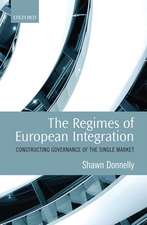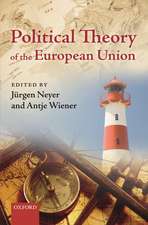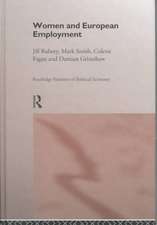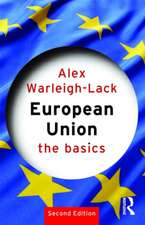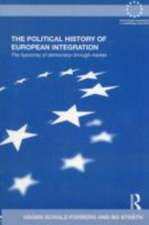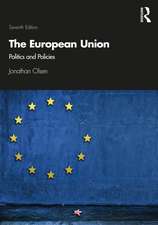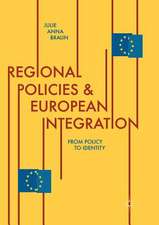The History of European Integration: A new perspective
Autor Ivan T. Berenden Limba Engleză Hardback – 15 iun 2016
The History of European Integration offers a major contribution to our understanding of Europe’s postwar history, and will be essential reading for any student of postwar European History, Contemporary History, European Politics and European Studies.
| Toate formatele și edițiile | Preț | Express |
|---|---|---|
| Paperback (1) | 341.08 lei 43-57 zile | |
| Taylor & Francis – 2 iun 2016 | 341.08 lei 43-57 zile | |
| Hardback (1) | 1112.34 lei 43-57 zile | |
| Taylor & Francis – 15 iun 2016 | 1112.34 lei 43-57 zile |
Preț: 1112.34 lei
Preț vechi: 1356.52 lei
-18% Nou
Puncte Express: 1669
Preț estimativ în valută:
212.85€ • 222.79$ • 177.16£
212.85€ • 222.79$ • 177.16£
Carte tipărită la comandă
Livrare economică 31 martie-14 aprilie
Preluare comenzi: 021 569.72.76
Specificații
ISBN-13: 9781138654907
ISBN-10: 1138654906
Pagini: 284
Ilustrații: 16
Dimensiuni: 156 x 234 mm
Greutate: 0.54 kg
Ediția:1
Editura: Taylor & Francis
Colecția Routledge
Locul publicării:Oxford, United Kingdom
ISBN-10: 1138654906
Pagini: 284
Ilustrații: 16
Dimensiuni: 156 x 234 mm
Greutate: 0.54 kg
Ediția:1
Editura: Taylor & Francis
Colecția Routledge
Locul publicării:Oxford, United Kingdom
Public țintă
Postgraduate and UndergraduateCuprins
Introduction
Chapter 1. Made in USA? The Origins of the European Integration from the 1940s
Chapter 2. Beginning of the European Integration and Enlargement
Chapter 3. Change of Guard in the 1970s: European Corporations Step into America’s Role
Chapter 4. Made by Corporate Europe? The ‘Second Coming’ of the European Integration, 1980s–2000s
Chapter 5. Creating an Europeanized economy with corporate assistance: the Single Market and Common Currency
Chapter 6. Towards a Europeanized economic Structure of Europe
Epilogue: Quo Vadis European Union?
Chapter 1. Made in USA? The Origins of the European Integration from the 1940s
Chapter 2. Beginning of the European Integration and Enlargement
Chapter 3. Change of Guard in the 1970s: European Corporations Step into America’s Role
Chapter 4. Made by Corporate Europe? The ‘Second Coming’ of the European Integration, 1980s–2000s
Chapter 5. Creating an Europeanized economy with corporate assistance: the Single Market and Common Currency
Chapter 6. Towards a Europeanized economic Structure of Europe
Epilogue: Quo Vadis European Union?
Notă biografică
Ivan T. Berend is Distinguished Research Professor at the Department of History, University of California, Los Angeles, USA.
Recenzii
‘Berend’s work makes a large and much-needed contribution to our understanding of the history of modern European integration with a focus on actors external to European countries themselves. This book will be helpful to anyone interested in post-war reconstruction, dynamics of the EU Single Market, and the modern day emphasis on market integration.’ — Valerie D’Erman, Post-Doctoral Research Fellow at the Department of Political Science University of Victoria, Canada
Descriere
The foundation of the European Union was one of the most important historical events in the second half of the 20th century. In order to fully appreciate the modern state of the EU, it is crucial to understand the history of European integration. This accessible overview differs from other studies in its focus on the major roles played by both the United States and European multinational corporations in the development of the European Union. Chronologically written and drawing on new findings from two major archives (the archives of the US State Department and Archive of European Integration), this book sheds crucial new light on the integration process.
The History of European Integration offers a major contribution to our understanding of Europe’s postwar history, and will be essential reading for any student of postwar European History, Contemporary History, European Politics and European Studies.
The History of European Integration offers a major contribution to our understanding of Europe’s postwar history, and will be essential reading for any student of postwar European History, Contemporary History, European Politics and European Studies.



